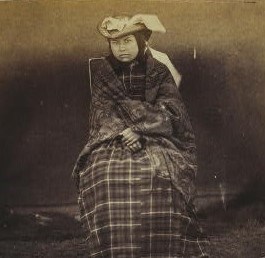Part of a series of articles titled Women's History in the Pacific West - Columbia-Pacific Northwest Collection.
Previous: Shirley Williams
Next: Ida Blackeagle
Article

Photo by British North American Boundary Commission, Courtesy Library of Congress Photograph
Article by: Emma Chapman
Christina McDonald McKenzie Williams was a multi-ethnic and multi-lingual fur trader, interpreter, rancher, and businesswoman who gained skills growing up in what is now the Lake Roosevelt Recreation Area that served her for a lifetime. She was born on September 20, 1847 to Angus McDonald, a Scottish fur trapper, and Catherine Baptiste, a Nez Perce woman who was related to the chief Eagle-of-the-Light. When Williams was young, the Hudson Bay Company appointed her father as chief factor of Fort Colvile (a site now inundated by Lake Roosevelt), and her family moved from her mother’s familial territory in Idaho to Washington. While at the fort, Williams learned Nez Perce stories from her mother and Scottish dances from her father. She was educated by a private tutor and was fluent in English, French, Nez Perce, and at least one other Indigenous language. Her facility in multiple cultures and languages made her an invaluable asset to her fort commander father, and she acted as hostess to and interpreter for the European, Anglo-American, and Indigenous American visitors to Fort Colvile. She also accompanied her father on business trips to Astoria and Portland and helped keep track of finances from their fur trade.i
In 1870 she married her father’s clerk, James McKenzie, and moved with him to Victoria, Canada where he became the chief trader of Kamloops post. When he died, Williams, then with two small children, took charge of the now independently-run trading post and faced fierce competition from the larger Hudson Bay Company and other richer merchants. After one particularly difficult winter, the larger traders bought up all the pack animals to bring in trade goods, hoping to squeeze Williams out. Undaunted, she “sent word by Indian courier…to the Indian pack train” and asked Indigenous men for help to transport the supplies back to Kamloops. Moving swiftly, her group made it back before the other merchants, allowing her to sell her inventory for a higher profit than those whose goods came later. As Williams said herself, “I more than held my own with them.”ii
Eventually, she married a man named Charles Williams and moved her family to a ranch she bought on the Shuswap Prairie in British Columbia. There, her quick thinking saved the Williams herds from theft on at least one occasion. One night while she was working at her general trading post store, she was informed that ranch jumpers were coming to claim her unattended land. She borrowed a horse and rode thirty miles through a cold night, arriving before the thieves and frightening them off. She and Williams had two more children and she continued to make trips to visit her mother and father, who had by then moved to Montana.iii
Throughout her life, Williams maintained connections to the Indigenous and Euro-American networks that crossed international lines in the North American West. Her cultural and linguistic skills helped her thrive in this world, sustained by multicultural families and businesses at the intersection of Indigenous and Euro-American communities in the US and Canada.
i - Jack Nisbet and Claire Nisbet, “Williams, Christina McDonald (1847-1925),” May 4, 2011, https://www.historylink.org/File/9802; Christina Macdonald McKenzie Williams, “The Daughter of Angus MacDonald,” The Washington Historical Quarterly 13, no. 2 (April 1, 1922): pp. 107-114.
ii - Nisbet and Nisbet, “Williams, Christina McDonald (1847-1925)”; Williams, “The Daughter of Angus MacDonald,” 115-116.
iii - Nisbet and Nisbet, “Williams, Christina McDonald (1847-1925)”; Williams, “The Daughter of Angus MacDonald,” 117.
This project was made possible in part by a grant from the National Park Foundation.
This project was conducted in Partnership with the University of California Davis History Department through the Californian Cooperative Ecosystem Studies Unit, CA# P20AC00946
Part of a series of articles titled Women's History in the Pacific West - Columbia-Pacific Northwest Collection.
Previous: Shirley Williams
Next: Ida Blackeagle
Last updated: February 22, 2022